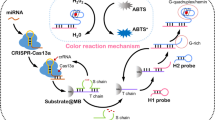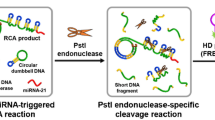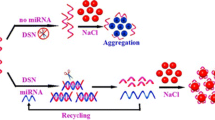Abstract
A sensitive and specific bioassay based on cyclic enzymatic amplification was developed for determination of microRNA (miRNA) by taking advantage of the exodeoxyribonuclease activity of T7 exonuclease (T7 Exo). In the presence of miRNA, DNA/RNA duplexes are formed by hybridization of miRNA and capture probes (Cp). Then, the Cp is digested to release miRNA into the next amplification cycle assisted by T7 Exo. This leads to the digestion of numerous Cp molecules. The broken Cp does no longer hybridize with hairpin probes (Hp) to unveil G-quadruplex DNAzyme (GDNAs). However, in the absence of miRNA, the Hp hybridizes with Cp to unveil GDNAs. The generated GDNAs form assemblies with hemin to form the G-quadruplex/hemin DNAzyme complex which is capable of catalyzing the oxidation of the substrate ABTS by H2O2. Upon cyclic enzymatic amplification, the output signal is reduced accordingly, this resulting in a “signal-off” signal best acquired at a wavelength of 418 nm. The lower detection limit is 0.69 pM (at an S/N ratio of 3). The assay involves efficient signal amplification, is homogeneous and isothermal, and enables visual detection. It provides a simple, rapid and sensitive platform for use in clinical diagnostics.

Schematic of a method for colorimetric and visual detection of miRNA using T7 exonuclease-based cycling signal amplification.





Similar content being viewed by others
References
Wen YQ, XU Y, Mao XH, Wei YL, Song HY, Chen N, Huang Q, Fan CH, Li D (2012) DNAzyme-based rolling-circle amplification DNA machine for ultrasensitive analysis of microRNA in drosophila larva. Anal Chem 84(18):7764–7669
Wang M, Yang Z, Guo Y, Wang X, Yin H, Ai S (2015) Visible-light induced photoelectrochemical biosensor for the detection of microRNA based on Bi2S3 nanorods and streptavidin on an ITO electrode. Microchim Acta 182(1–2):241–248
Shi HB, Xu J, Zhang GD, Xu LD, Li CQ, Wang L, Zhao Z, Jiang W, Guo Z, Li X (2013) Walking the interactome to identify human miRNA-disease associations through the functional link between miRNA targets and disease genes. BMC SystBiol 7(1):1–12
Li DD, Cheng W, Yan YR, Zhang Y, Yin YB, Ju HX, Ding SJ (2016) A colorimetric biosensor for detection of attomolar microRNA with a functional nucleic acid-based amplification machine. Talanta 146:470–476
Deng RJ, Tang LH, Tian QQ, Wang Y, Lin L, Li JH (2014) Toehold-initiated rolling circle amplification for visualizing individual microRNAs in situ in single cells. Angew Chem Int Ed 53:2389–2393
Wang GL, Zhang CY (2012) Sensitive detection of microRNAs with hairpin probe-based circular exponential amplification assay. Anal Chem 84(16):7037–7042
Shah P, Thulstrup PW, Cho SK, Bhang YJ, Ahn JC, Choi SW, Yang SW (2014) In-solution multiplex miRNA detection using DNA-templated silver nanocluster probes. Analyst 139(9):2158–2166
Cho WC (2010) MicroRNAs: potential biomarkers for cancer diagnosis, prognosis and targets for therapy. Int J Biochem Cell B 42(8):1273–1281
Li Y, Liang L, Zhang CY (2013) Isothermally sensitive detection of serum circulating miRNAs for lung cancer diagnosis. Anal Chem 85(23):11174–11179
Várallyay E, Burgyán J, Havelda Z (2008) MicroRNA detection by northern blotting using locked nucleic acid probes. Nat Protoc 3(2):190–196
Duan R, Zuo X, Wang S, Quan X, Chen D, Chen Z, Xia F (2013) Lab in a tube: ultrasensitive detection of microRNAs at the single-cell level and in breast cancer patients using quadratic isothermal amplification. J Am Chem Soc 135(12):4604–4607
Nagl S, Schaeferling M, Wolfbeis OS (2005) Fluorescence analysis in microarray technology. Microchim Acta 151(1–2):1–21
Zhang DC, Yan YR, Cheng W, Zhang W, Li Y, Ju HX, Ding SJ (2013) Streptavidin enhanced surface plasmon resonance biosensor for highly sensitive and specific detection of microRNA. Microchim Acta 180:397–403
Liu H, Bei X, Xia Q, Fu Y, Zhang S, Liu M, Yang Y (2016) Enzyme-free electrochemical detection of microRNA-21 using immobilized hairpin probes and a target-triggered hybridization chain reaction amplification strategy. Microchim Acta 183(1):297–304
Zuo X, Xia F, Xiao Y, Plaxco KW (2010) Sensitive and selective amplified fluorescence DNA detection based on exonuclease III-aided target recycling. J Am Chem Soc 132:1816–1818
Xu M, He Y, Gao Z, Chen G, Tang D (2015) Isothermal cycling and cascade signal amplification strategy for ultrasensitive colorimetric detection of nucleic acids. Microchim Acta 182(1):449–454
Huang KW, Yu CJ, Tseng WL (2010) Sensitivity enhancement in the colorimetric detection of lead (II) ion using gallic acid-capped gold nanoparticles: improving size distribution and minimizing interparticle repulsion. Biosens Bioelectron 25(5):984–989
Fu XL, Chen LX, Li JH, Lin M, You HY, Wang WH (2012) Label-free colorimetric sensor for ultrasensitive detection of heparin based on color quenching of gold nanorods by graphene oxide. Biosens Bioelectron 34(1):227–231
Martin A, Palomino JC, Portaels F (2005) Rapid detection of of loxacin resistance in mycobacterium tuberculosis by two low-cost colorimetric methods: resazurin and nitrate reductase assays. J Clin Microbiol 43(4):1612–1616
Bi S, CuiY LL (2013) Dumbbell probe-mediated cascade isothermal amplification: a novel strategy for label-free detection of microRNAs and its application to real sample assay. Anal Chim Acta 760:69–74
Wang F, Lu CH, Liu X, Freage L, Willner I (2014) Amplified and multiplexed detection of DNA using the dendritic rolling circle amplified synthesis of DNAzyme reporter units. Anal Chem 86(3):1614–1621
Cheng Y, Zhang X, Li Z, Jiao X, Wang Y, Zhang Y (2009) Highly sensitive determination of microRNA using target-primed and branched rolling-circle amplification. Angew Chem Int Ed 48(18):3268–3272
Hall MJ, Wharam SD, Weston A, Cardy DLN, Wilson WH (2002) Use of signal-mediated amplification of RNA technology (SMART) to detect marine cyanophage DNA. BioTechniques 32(3):604–611
Jia H, Li Z, Liu C, Cheng Y (2010) Ultrasensitive detection of microRNAs by exponential isothermal amplification. Angew Chem Int Ed 49(32):5498–5501
Nie J, Zhang DW, Tie C, Zhou YL, Zhang XX (2014) G-quadruplex based two-stage isothermal exponential amplification reaction for label-free DNA colorimetric detection. Biosens Bioelectron 56:237–242
Xuan F, Luo X, Hsing IM (2012) Ultrasensitive solution-phase electrochemical molecular beacon-based DNA detection with signal amplification by exonuclease III-assisted target recycling. Anal Chem 84(12):5216–5220
Wang M, Fu Z, Li B, Zhou Y, Yin H, Ai S (2014) One-step, ultrasensitive, and electrochemical assay of microRNAs based on T7 exonuclease assisted cyclic enzymatic amplification. Anal Chem 86(12):5606–5610
Wu ZK, Zhou DM, Wu Z, Chu X, Yu RQ, Jiang JH (2015) Single-base mismatch discrimination by T7 exonuclease with target cyclic amplification detection. Chem Commun 51(14):2954–2956
Shinozaki K, Tuneko O (1978) T7 gene 6 exonuclease has an RNase H activity. Nucleic Acids Res 5(11):4245–4262
Kerr C, Sadowski PD (1972) Gene 6 exonuclease of bacteriophage T7 purification and properties of the enzyme. J Biol Chem 247(1):305–310
Ma Y, Chen L, Zhang L, Liao S, Zhao J (2015) A sensitive strategy for the fluorescence detection of DNA methyltransferase activity based on the graphene oxide platform and T7 exonuclease-assisted cyclic signal amplification. Analyst 140(12):4076–4082
Wang HB, Wu S, Chu X, Yu RQ (2012) A sensitive fluorescence strategy for telomerase detection in cancer cells based on T7 exonuclease-assisted target recycling amplification. Chem Commun 48(47):5916–5918
Cui L, Zhu Z, Lin NH, Zhang HM, Guan ZC, Jamesá Yang C (2014) A T7 exonuclease-assisted cyclic enzymatic amplification method coupled with rolling circle amplification: a dual-amplification strategy for sensitive and selective microRNA detection. Chem Commun 50(13):1576–1578
Zhang H, Li M, Li C, Guo Z, Dong H, Wu P, Cai C (2015) G-quadruplex DNAzyme-based electrochemiluminescence biosensing strategy for VEGF165 detection: combination of aptamer-target recognition and T7 exonuclease-assisted cycling signal amplification. Biosens Bioelectron 74:98–103
Shi HY, Yang L, Zhou XY, Bai J, Gao J, Jia HX, Li QG (2017) A gold nanoparticle-based colorimetric strategy coupled to duplex-specific nuclease signal amplification for the determination of microRNA. Microchim Acta 2016:1–7
Oishi M, Sugiyama S (2016) An efficient particle-based DNA circuit system: catalytic disassembly of DNA/PEG-modified gold nanoparticle-magnetic bead composites for colorimetric detection of miRNA. Small 12(37):5153–5158
Wang Q, Li RD, Yin BC, Ye BC (2015) Colorimetric detection of sequence-specific microRNA based on duplex-specific nuclease-assisted nanoparticle amplification. Analyst 140(18):6306–6312
Miao X, Ning X, Li Z (2016) Cheng Z (2016) sensitive detection of miRNA by using hybridization chain reaction coupled with positively charged gold nanoparticles. Sci Rep 6:32358
Acknowledgements
This work was supported by the National Natural Science Foundation of China (81572080, 81101638), Natural Science Foundation Project of Chongqing (cstc2014kjrc-qnrc10001), and Achievement Transfer Project of Institutions of Higher Education in Chongqing (KJZH14205).
Author information
Authors and Affiliations
Corresponding author
Ethics declarations
The authors declare that they have no conflict of interest. This article does not contain any studies with animals performed by any of the authors.
Additional information
Ye Sang and Yongjie Xu are contributed equally to this work.
Electronic supplementary material
ESM 1
(DOC 330 kb)
Rights and permissions
About this article
Cite this article
Sang, Y., Xu, Y., Xu, L. et al. Colorimetric and visual determination of microRNA via cycling signal amplification using T7 exonuclease. Microchim Acta 184, 2465–2471 (2017). https://doi.org/10.1007/s00604-017-2238-8
Received:
Accepted:
Published:
Issue Date:
DOI: https://doi.org/10.1007/s00604-017-2238-8




